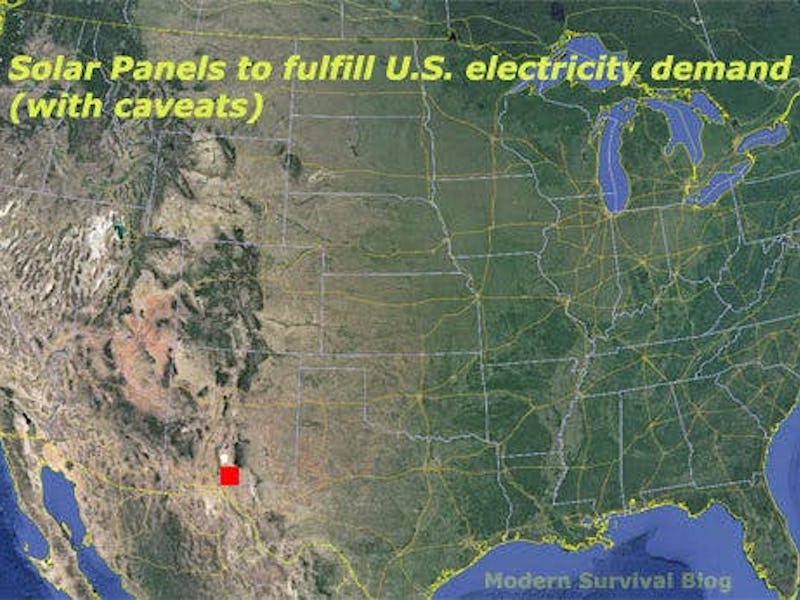Elon Musk revives his plan to power the United States entirely on solar
The CEO of the company that sells the Tesla Solar Roof speaks out.

Could you meet the United States entirely from solar energy? Sure, claims tech entrepreneur Elon Musk.
The Tesla CEO, whose company provides solar panel solutions like the Solar Roof, shared a video via Twitter on Saturday of the electricity-generating tiles taking a beating from a hammer. One fan responded to Musk’s video with a 2011 quote from Bill Gates, who described solar and similar technologies as “cute,” but that the answer is in nuclear power.
Musk hit back at the quote by describing Gates’ assertion as “def wrong.”
He’s def wrong. Solar power is a Gigawatt per square km! All you need is a 100 by 100 mile patch in a deserted corner of Arizona, Texas or Utah (or anywhere) to more than power the entire USA.
It’s a revival of an idea Musk has shared several times, that enough solar panels could power the entire United States. It’s an idea he shared in 2015, and reiterated in 2017.
“The batteries you need to store the energy, so you have 24/7 power, is 1 mile by 1 mile. One square-mile,” Musk said in 2017. He continued that it’s “a little square on the U.S. map, and then there’s a little pixel inside there, and that’s the size of the battery park that you need to support that. Real tiny.”
The plan itself is clearly a flawed idea — collecting and storing electricity in one small patch of land is just a storm away from knocking the entire country offline — but it illustrates a more realistic proposal that people can meet their electricity demands from zero-emissions sources.
Tesla's Solar Roof tiles.
Elon Musk’s plan: how would it work?
When Musk outlined the plan at the National Governors Association meeting in July 2017, he outlined a system where the panels would provide the power and batteries would store the electricity for use round-the-clock. By Musk’s calculations, the panels would require a patch of land measuring 100 miles by 100 miles (or 10,000 square miles). The battery would requite one square mile of land.
Does it work? University College London explored Musk’s idea in 2015 to see if it would work. They used EIA figures that showed the United States used 3,725 Terawatt-hours in one year in 2013, or the equivalent rate of 425 gigawatts.
They then looked at the average photovoltaic yield in Amarillo, Texas. A one-kilowatt system would offer 1,838 kilowatt-hours per year, the equivalent of 210 watts, which gives an efficiency rating of 21 percent. As the highest-efficiency solar module at the time offered 24 percent efficiency, that gives an efficiency of 0.24 gigawatts per square kilometer.
The UCL analysis assumes Musk was proposing a square that measures 100 kilometers on each side, or 62 miles. But even under these more conservative figures, the analysis suggests it should work: 10,000 square kilometers, multiplied by 0.24 gigawatts per square kilometer, multiplied by 0.21 gives us just over 500 gigawatts. That’s higher than the country’s annual electricity consumption rate of 425 gigawatts.
Of course, Musk clarified these figures two years later so the patch of land would measure 10,000 square miles, or 25,900 square kilometers. Putting that figure into the equation results in 1,305 terawatts.
This also corresponds with analysis from Modern Survival Blog published in March 2019. This found that covering a 1,939-square-mile patch of land, 44 miles each side, with 250-watt Sharp ND-250QCS solar panels would be enough to meet energy demands.
Floating solar panels.
The idea is impractical for a number of reasons. What if a natural disaster strikes the country’s only source of electricity? What about the dependence created on the infrastructure transmitting that electricity? Would the locals perhaps have something to say about thousands of square miles of land getting transformed into a shiny solar-collecting surface?
Indeed, much like the idea to power the world by covering the Sahara Desert in solar panels, or putting a giant floating wind farm in the Atlantic Ocean, the suggestion isn’t so much a call to pick up a shovel and start covering a chunk of the Earth’s surface. It’s more to highlight how humanity has the technology to offer zero-emissions electricity.
With that in mind, the question then becomes, how do we deploy this on a large scale?